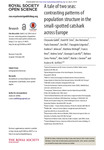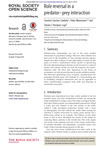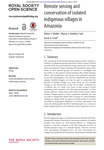Search
Now showing items 1-10 of 154
Can outcomes of dyadic interactions be consistent across contexts amongwild zebrafish?
(The Royal Society, 2015)
Winner–loser relations among group-living individuals are often measured by the levels of aggressive interactions between them. These interactions are typically driven by competition for resources such as food and mates. ...
A tale of two seas
(2014)
Elasmobranchs represent important components of marine ecosystems, but they can be vulnerable to overexploitation. This has driven investigations into the population genetic structure of large-bodied pelagic sharks, but ...
Repeatability in the contact calling systemof Spix’s disc winged bat
(2015)
Spix’s disc-winged bat (Thyroptera tricolor) forms cohesive groups despite using an extremely ephemeral roost, partly due to the use of two acoustic signals that help individuals locate roost sites and group members. While ...
Local plant adaptation across a subarctic elevational gradient
(2014)
Predicting how plantswill respond to global warming necessitates understanding of local plant adaptation to temperature. Temperature may exert selective effects on plants directly, and also indirectly through environmental ...
Light-emitting diode street lights reduce last-ditch evasivemanoeuvres by moths to bat echolocation calls
(The Royal Society, 2015)
The light-emitting diode (LED) street light market is expanding globally, and it is important to understand how LED lights affect wildlife populations. We compared evasive flight responses of moths to bat echolocation calls ...
Effects of habitat structure and land use intensity on the genetic structure of the grasshopper species Chorthippus parallelus
(2014)
Land-use intensity (LUI) is assumed to impact the genetic structure of organisms. While effects of landscape structure on the genetics of local populations have frequently been analysed, potential effects of variation in ...
Role reversal in a predator–prey interaction
(2014)
Predator–prey relationships are one of the most studied interactions in population ecology. However, little attention has been paid to the possibility of role exchange between species, despite firm field evidence of such ...
Remote sensing and conservation of isolated indigenous villages in Amazonia
(2014)
The vast forests on the border between Brazil and Peru harbour a number of indigenous groups that have limited contact with the outside world. Accurate estimates of population sizes and village areas are essential to begin ...
Discrete but variable structure of animal societies leads to the false perception of a social continuum
(2016)
Animal societies are typically divided into those in which reproduction within a group is monopolized by a single female versus those in which it is shared among multiple females. It remains controversial, however, whether ...
Artificial light onwater attracts turtle hatchlings during their near shore transit
(2016)
We examined the effect of artificial light on the near shore trajectories of turtle hatchlings dispersing from natal beaches. Green turtle (Chelonia mydas) hatchlings were tagged with miniature acoustic transmitters and ...










